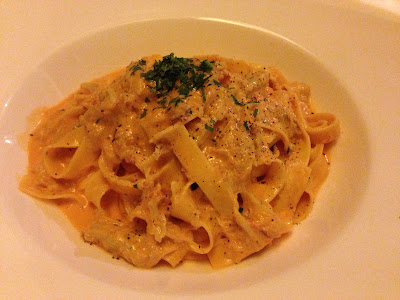Angus Steak House has been in Ngee Ann City for more than ten years, comfortably tucked at the boundary of Takashimaya departmental store on the fourth floor. It was my first visit here, and to celebrate my father's birthday. As my father (and I) were huge fan of steaks, I decided to try out this place as we had already tried Morton's and Lawry's before.
Prices of the steaks ranged from $40+ to $60+, depending on the size and cut. My advice is to go for the largest cut (300g) because of the value-for-money. For example, 300g of ribeye costs $63, but 250g already costs around $56. And top up $10 to make it a dinner set - comes with bread, soup, starter, salad, and dessert.
 |
| Hors d'oeuvre - chicken |
For the starter, we had a choice of chicken or fish. I found this to be normal only, but my mother fancied it.
 |
| Hors d'oeuvre - threadfin fish |
Nothing impressive about this dish. I thought the chicken was slightly better than this.
 |
| Bread |
The bread was freshly toasted, and once you remove its cap, you can see a bit of steam wafting out. It was quite delicious and crispy, though I think they were a bit too stingy on the butter. I didn't request for more, though I am sure they wouldn't mind serving extra.
 |
| Crab meat chowder |
This was quite disappointing - there was zero taste of crab inside. I managed to find one miserable piece of crab meat inside, and even this piece did not taste like crab.
 |
| Green salad with Japanese salad sauce |
The dressing was probably a mixture of Japanese soya sauce and a bit of sesame oil. This wasn't done uniformly; mine had a bit too much dressing while my mother's had practically none.
 |
| Charcoal grilled ribeye steak, medium rare. $63 for 300g |
Finally, the main course. My father, brother, and I ordered the 300g ribeye steak each. Firstly, there was no way this steak could weigh 300g. It was too thin, for one thing. And my mother has always prepared 1kg of beef for our Sunday lunches for four of us - and our four orders of 300g steaks did not even appear to come close! It should be 1.2kg in total, but it seemed more like 800g.
But the steak was done pretty well, and it was extremely tender. The Japanese sauce appeared to be a mixture of radish, Japanese soya sauce, and probably some miso - and it was a welcome change to the common red wine or black pepper sauce. But I found the lime and butter quite unnecessary, as it seemed to clash a bit with the steak.
 |
| Charcoal grilled sirloin steak, medium. $58 for 300g |
Compared to the ribeye steak, the sirloin steak was slightly tougher, but on its own, it could already be considered quite tender. The beef flavour for this was a bit stronger than the ribeye, so this was quite good as well.
 |
| Tiramisu |
For desserts, we had a choice of either tiramisu or ice cream. The tiramisu was pretty good; served in a modest portion and ended the meal on a nice note.
Compared to Morton's or Lawry's, Angus Steak House is cheaper and you get to try a much wider variety of food. The food is not fantastic, especially the starters and so on, but the beef is still all right. However, when it comes to service, it fairs much more poorly. While the service staff were definitely not rude, they were obviously inexperienced, and either fumbled when serving us, or did not seem to know where to place our bread and starters.
And finally, if you are having dinner here, don't ever get a window seat. Angus Steak House actually faces Orchard Road, and the spotlights for Ngee Ann City actually shine right in - it was extremely glaring and uncomfortable.

































